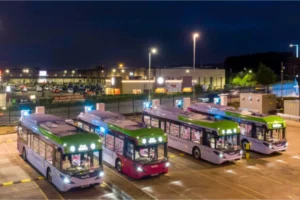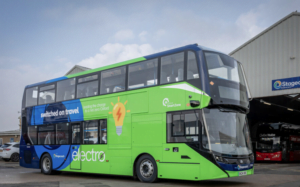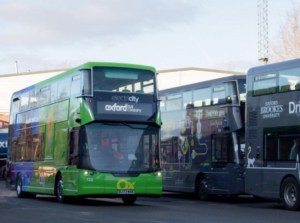Ember has announced that it has raised an £11 million Series A financing round, led by Inven Capital, 2150 and AENU. Existing investors Pale Blue Dot and SkyScanner co-founder Gareth Williams also participated in the oversubscribed round. The company will use the funding to accelerate the rollout of its electric bus services and further invest in EmberOS, the platform that controls the network and delivers a game-changing customer experience.
Ember is tackling the challenge of electrifying the most highly utilised vehicles on the road – intercity buses. These often travel over 250,000 kilometres per year, far exceeding the average mileage of even long-distance trucks. The vast distances and large vehicle size mean the emissions saved from electrifying each intercity bus far outweighs other vehicle categories.
Rather than just providing software to help legacy operators go electric, Ember is taking a full-stack, first-principles approach to create a new, highly optimised, all-electric network. This allows Ember to flexibly scale across multiple geographies and seamlessly adapt to shifting passenger demands to offer a superior customer experience at lower cost – all with zero emissions.
This approach includes building its own dedicated ultra-fast charging network, designing and operating its own routes and working closely with its manufacturing partner on vehicle development. Everything is brought together by EmberOS, the proprietary tech platform that orchestrates all operations – including charge management, routing, and end-to-end network optimisation.
The goal is to both take advantage of the superior margins achieved by optimal use of electric buses and to take cars off the road by offering a dramatically superior and far more climate-friendly travel experience at a lower cost. Ember has five new charging hubs under parallel development, all modelled on their core hub blueprint. Ember’s Dundee hub is capable of delivering charging speeds of 600 kW to a single bus, with a large proportion of the power coming from the 4 MW of on-site wind turbines. Future hubs are co-located with renewables where possible, further reducing energy costs.
Over 750,000 journeys have already been made with Ember and that’s expected to double over the coming year as the network expands. Ember will soon take delivery of the first batch of its next-generation bus, with a 563 kWh battery and a range of over 500 kilometres. Ember is running services 24/7 at an hourly frequency. Each bus covers up to 900 kilometres per day with multiple high-speed charging sessions.
Keith Bradbury, co-founder of Ember, said “Travelling by bus or coach doesn’t have to be rubbish. It should be possible to deliver an experience that beats a car – because someone else is doing the driving so you can have your time back – but that requires a relentless focus on the passenger experience. Things like live tracking that actually works, super-simple pricing, easy ticket changes and near-perfect reliability.”
“Under the hood it’s a delightfully complicated problem to solve” adds Pierce Glennie, co-founder of Ember. “EmberOS is the digital twin of our network, and we continue to add layers of data that enable the system to always know what’s going on. That means things like real-time vehicle states, current traffic conditions, nearby bus lanes, battery cell temperatures and the health of our chargers. When you put all of that together you can really bring down operational costs and deliver a better experience.”




















